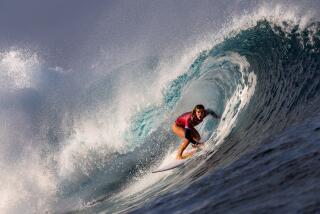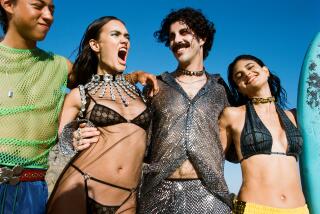K2 Is Newest Surf Apparel Dude in Town
Ski and snowboard maker K2 is heading for the beach.
Beginning next month, shorts, shirts and caps emblazoned with the K2 logo will begin appearing in Southland surf shops as the company takes a risk almost as big as those taken by some of the extreme sports athletes it outfits.
The Los Angeles sports equipment maker is using last year’s acquisition of Katin USA in Costa Mesa as a springboard into the $1.7-billion surf wear industry.
Its new K2 Surf line comes on the heels of a marketing campaign that captivated the surfing crowd by offering $50,000 to the surfer who rides the biggest wave this winter.
Surfers, bags packed and airline tickets ready, have raced to get to the best waves over the last four months. Two, Taylor Knox and Peter Mel, navigated monster barrels estimated at nearly 50 feet. The winner will be announced March 31.
With K2’s “Big Wave Challenge” trumpeting its new apparel line, the company now will be going head-to-head with larger, better-known names such as Quiksilver, Billabong and Gotcha.
Costa Mesa-based Quiksilver is already girding for a fight over the hallowed waters of surfing, where such big-name companies as Guess and Nike have flopped. And surfers themselves are wary of outsiders, which may make it difficult for K2 to win their hearts and minds, not to mention their pocketbooks.
“It’s really a rude thing to have a company come into the surf world and think they’re honorable because they’re offering a reward for something most guys wouldn’t normally do,” Laird Hamilton, a big-wave rider from Maui, told Surfer magazine.
But K2 has shown an uncanny ability to venture successfully into new territory, largely by hiring executives, buying companies and signing athletes who are known and respected.
And the big-wave contest has created some serious swells on Southern California’s surf scene, from Rincon Beach in Santa Barbara to Black’s Beach near La Jolla.
It has been the topic of lunchtime conversation at Wahoo’s Fish Taco in Costa Mesa, a popular surf hangout. And it helped Jack’s Surf Boards in Huntington Beach sell 500 “Big Wave Challenge” T-shirts in four months at $16.95 a pop.
The contest “has been near-genius,” said Steve Hawk, editor of Surfer magazine in Dana Point. “Surfers are already sizing up waves according to their ‘K2 potential.’ ”
It also had the unintended effect of upstaging the annual Eddie Aikau competition at Waimea Bay in Hawaii, tweaking the nose of industry leader Quiksilver, which sponsors that event. And last month, K2 signed Quiksilver rider Tim Curran, the No. 1 surfer on the American tour, to a three-year, six-figure endorsement deal.
Those developments aren’t sitting well with the Big Daddy of the surf industry.
“I think they’ll look silly trying to get into this business,” said Bob McKnight, Quiksilver co-founder and chairman. “It would be like if we went out to do ski wear. Our market is very suspicious of stuff that is contrived, that comes on too strong and is not part of the history and culture of the sport.”
But Katin, which has made board shorts since 1958, is a known entity to surfers. K2 is hanging its hopes for a successful launch on Katin’s good name, and the early results have been encouraging.
“We’ve been a Katin dealer for years so it was just second nature for us to add K2,” said Paul Nielsen, owner of Waveline Surf Shop in Ventura, who placed an initial order for $2,000 worth of clothing. “The similarity with Katin was real strong, which makes it really easy for me to sell.”
The 20-piece K2 line, put together by Katin designer Rich Lohr, is tiny by industry standards. Typically, the bigger brands have more than 150 different types of garments and accessories in a season.
K2 plans to sell its clothes only to surf shops, avoiding department and mainstream apparel stores.
“If we do $1 million in sales this year, that will be a great thing,” said Katin President Bill Sharp, a big-wave surfer who dreamed up the contest. Over the next five years, K2 expects sales from surf apparel to grow to a $25-million-a-year business.
K2, named for its founders, the Kirschner brothers, established itself with skis in the 1970s. In the late 1980s, it became the first ski outfit to make the jump successfully into snowboarding, a sport whose participants think of skiers as wimps.
In 1995, it introduced a step-in binding system that is now sweeping the industry. Today K2 has the second-largest share of the snowboard market, trailing only industry pioneer Burton Snowboards of Vermont.
Based on that success, K2 has put its name on everything from bicycles to in-line skates to snowshoes, developing ground-breaking technology with each product introduction. The company also makes Stearns life jackets, Shakespeare fishing tackle, Dana Design backpacks and a host of other recreational products.
“Our goal is to be the leader in technology and innovation and be No. 1 or No. 2 in any market we enter,” said Bonnie Crail, a surf industry veteran who heads K2’s Z Sports division.
That goal has given it a reputation for technical prowess in the sports world.
The company’s skis and new clap skates accounted for 17 medals at the recently concluded Winter Olympics in Nagano, Japan.
Despite its successes, and largely because of flattened in-line skate prices, K2 expects profit through the first half of this year to be below year-earlier levels, which has kept its stock in the low $20s since late January. Shares closed Wednesday at $21.38, down 31 cents, in New York Stock Exchange trading.
Industry analyst Shawn Milne of Hambrecht & Quist in San Francisco sees K2’s earnings rising about 10% this year to about $24 million, but that would still be shy of the record $25.2 million it earned in 1996.


